Meeting Strict Nitrogen and Phosphorus Discharge Limits
A Guide to Effective Nutrient Removal Using BIological and Physical-Chemical Processes

Excess nutrients in wastewater can have a number of serious environmental and health impacts. One of these environmental impacts is known as eutrophication. When there are high concentrations of nitrogen and phosphorus in a water body, an overgrowth of phytoplankton like cyanobacteria can occur, creating an algal bloom.
Their decomposition can create a large biological and chemical oxygen demand. This deprives organisms such as fish of oxygen. High concentrations of algae can also block out sunlight, affecting aquatic flora. In addition to eutrophication, certain nutrients, such as ammonia, are extremely toxic to aquatic life.
There are potentially significant impacts on human health too. Drinking water with high concentrations of nitrate can pose serious risks to children and pregnant women. It can cause a condition called, methemoglobinemia, also known as ‘Blue Baby Syndrome,’ a condition where the blood cannot efficiently transfer oxygen to cells throughout the body. Studies show that increased nitrates in the drinking water may result in a higher risk for cancer in some individuals.
Regulatory drivers and tighter rules
Nutrients can come from a variety of natural sources, for example from the weathering of rock. Yet it is typically human actions, such as the use of agricultural fertilizers or industry cleaning chemicals, that lead excess concentrations in the environment.
In the US, the National Pollutant Discharge Elimination System (NPDES) was introduced under the 1972 Clean Water Act to regulate point source discharges. Though the Clean Water Act made great strides in reducing pollution within watersheds, nutrient discharge limits were largely not a core focus within NPDES permits for many years. This trend has been changing for the last few decades, and it is expected that nutrient discharge limits will only continue to be more strict.
From 2000 onwards the EPA published federal nutrients criteria and since then the rules for direct discharges have been getting more strict with the hope to protect surface waters from their impact. As a result, it is more and more common to see new or updated permits getting very tight, in regards to nitrogen and phosphorus.

According to recent data published by the EPA, the vast majority of wastewater treatment facilities do not have any permit limit requirements for nitrogen or phosphorus. To meet the aggressive nutrient removal targets set forth by the EPA, new and renewal NPDES permits with specific nitrogen and phosphorus limits are expected to exponentially increase in the upcoming years.
Source: EPA Status of Nutrient Requirements for NEDES-Permitted Facilities
Consequently, companies with point source discharges are considering adopting better technologies to remove nutrients down to very low levels. Organizations focused on removing nitrogen and phosphorus are now integrating high-performance biological and physical-chemical wastewater treatment technologies to help ensure the treated wastewater is compliant in regards to nutrient permit limits.
Nitrogen and Phosphorus Removal Using High-Performance Technologies
Biological Nutrient Removal Processes
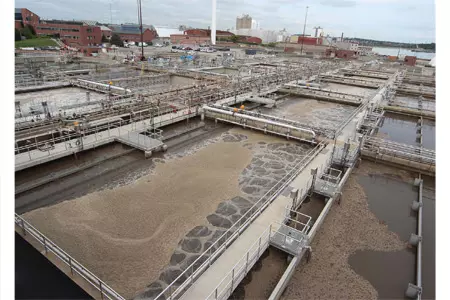
Nitrogen is one of the most common nutrients found within wastewater and typically appears as ammonia, which must be converted to nitrate/nitrite, in a process called nitrification, by providing oxygen. Then through the process of denitrification, the nitrate is converted into elemental nitrogen and is then removed by off-gassing.
There are several methods to remove ammonia in wastewater, such as activated sludge configured in stages, sequencing batch reactors, as well as MBRs. To supplement or improve treatment performance, many companies are incorporating the use of Moving Bed Biofilm Reactors (MBBR).
MBBRs perform similarly to activated sludge systems, but there is a stark difference. Rather than having the biomass in suspension, the process uses a fixed film attached to carriers that circulate within a reactor. This allows for more treatment capacity in a smaller footprint when compared to conventional biological systems.
In a two-stage MBBR system, the first reactor is configured to be aerobic to convert ammonia to nitrate, then the second rector utilizes anoxic bacteria and carbon addition for denitrification. This 2-step process is a very effective nutrient removal process.

For wastewater with high ammonia concentrations, MBBR’s can be configured to two-step nitrogen removal within a single reactor. Using a technology called Anita™Mox, specially cultured anammox bacteria is able to perform nitrification and denitrification in one single step.
This process provides only enough oxygen to convert some of the ammonia to nitrate and then we rely on the specific organisms to convert ammonia and nitrate into elemental nitrogen. It is a very efficient process that consumes approximately 60% less oxygen. Using less oxygen removes the need to provide several steps to provide proper metabolic pathways. This can save capital expenditure on tankage, as well as operating costs on the energy required for oxygenation and so forth.
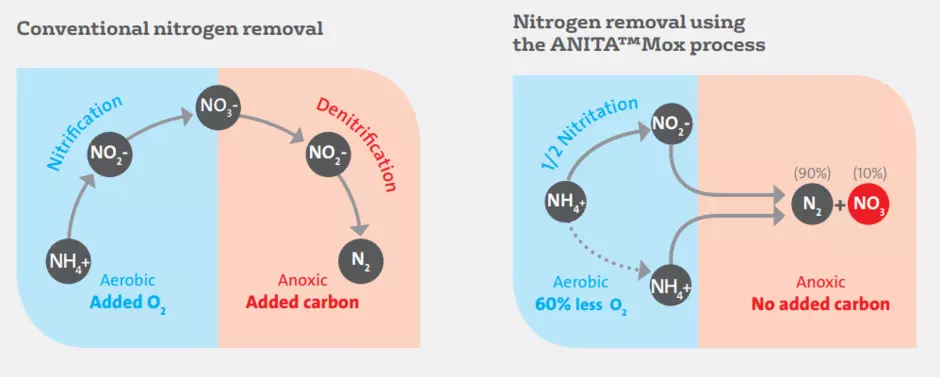
For wastewaters high in phosphorus, it is also possible to utilize biological processes as a primary process for phosphorus removal. By integrating a specialized high-acidification step within the biological treatment process, it is possible to culture a biomass that can hold between 30-40% of its mass in phosphorus, and then the biomass can be removed in a clarification or filtration step downstream. This biological process helps shift the burden away from physical-chemical processes, thus saving in chemical costs or extra equipment.
Physical-Chemical Phosphorus Removal
Depending on the required effluent requirements, one or more physical and chemical technologies may be needed after biological treatment to remove any remaining orthophosphates to meet required discharge permit limits. By incorporating iron or aluminum based salts within the polishing treatment stage, it is possible to simultaneously remove phosphorus and total suspended solids (TSS) to very low concentrations within the same polishing step.
Three common polishing technologies are high-rate clarifiers, dissolved air flotation units (DAFs), and disc/drum filters.
In each of these physical-chemical treatment processes, the wastewater is dosed with specific chemistries with the goal of precipitating phosphorus and forming flocs. As the floc size increases, it will either settle, float, or be screened, effectively removing the phosphorus and remaining TSS within the wastewater stream.
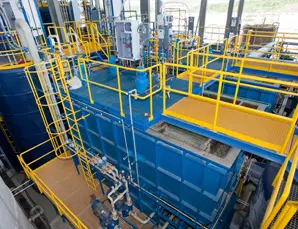
Actiflo® High-Rate Clarifier/Softener
Small-footprint technology in which water is flocculated with microsand and polymer to increase settling velocity for the removal of more than 99% of TSS.
Learn More
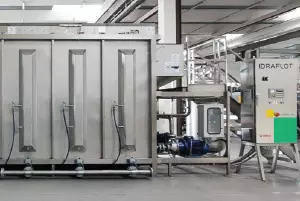
IDRAFLOT® Dissolved Air Flotation (DAF)
An innovative and effective wastewater treatment technology based on a unique modular design to remove suspended solids and FOG (fats, oils, and grease)
Learn More
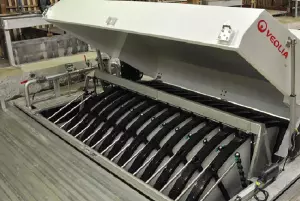
Hydrotech Drumfilters & Discfilters
Filtration technology that uses woven media panels to remove suspended solids greater than 10 microns
Learn More
Getting Started with the Right Approach
As companies face stricter regulations on the discharge of nutrients like nitrogen and phosphorus, new treatment processes may need to be adopted. Also if a company is looking to install a new wastewater treatment plant, it’s critical to ensure the process is flexible to be able to meet the needs of not only the current permit limits, but allow for the potential to meet future expansions or permit requirements. We call this “future-proofing.”
While there is a wide range of chemical, physical and biological processes that can address this issue, it is important to select the right approaches that are both robust and economically viable.
Learn More! Free On-Demand Webinar
Interested in learning more on this topic? Listen to our on-demand webinar.
Nutrient Removal Using Advanced Wastewater Treatment Technologies (Phosphorus & Nitrogen Removal)


